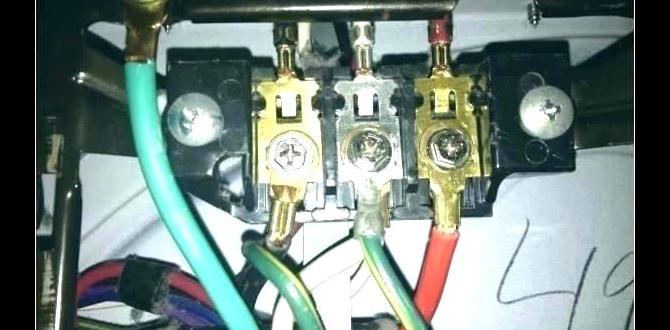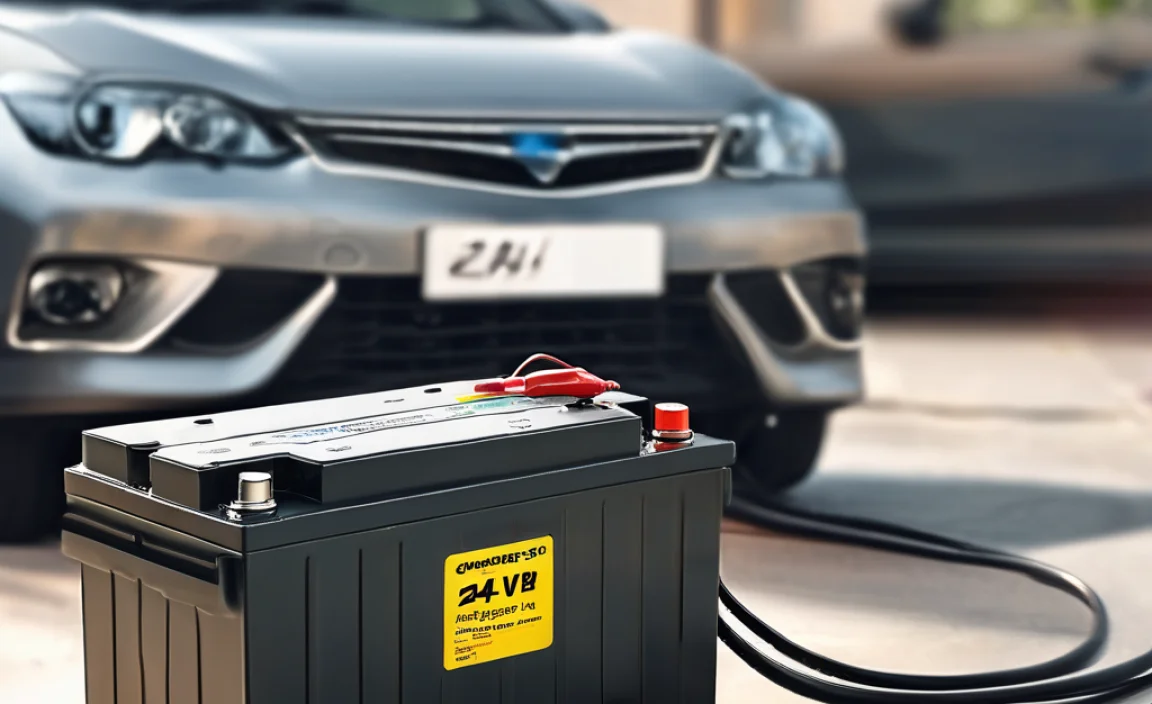The idea of using a cheap lead acid car battery for electric cars is a common misconception. While lead-acid batteries are essential for starting conventional gasoline cars, they are NOT the primary power source for the high-voltage battery systems in modern electric vehicles (EVs). However, many EVs do use a smaller, standard 12-volt lead-acid battery for auxiliary functions. This guide clarifies the role and importance of these 12V batteries in EVs.
Understanding the “Cheap Lead Acid Car Battery” in Electric Cars
When most people think of an electric car, they picture a sleek, modern vehicle powered entirely by a giant, advanced battery pack. And for the most part, that’s true! The main battery that drives the electric motor is a sophisticated lithium-ion system, designed for high energy density and long life. However, beneath the shiny exterior, almost every electric car still relies on a familiar component: a standard 12-volt lead-acid car battery. This might sound a bit surprising, especially when you hear about “cheap lead acid car battery for electric cars,” but this small battery plays a surprisingly critical role.
Think of your electric car’s main battery as the engine, quietly and efficiently powering your drive. The 12-volt battery, on the other hand, is more like the car’s essential electrical hub. It’s responsible for powering all the “creature comforts” and critical systems that need electricity even when the main high-voltage battery isn’t actively engaged for driving. This includes everything from your headlights and interior lights to your infotainment system, power windows, door locks, and the computers that manage the car’s safety features and wake up the main battery when you are ready to drive.
This guide is here to help you understand why this 12-volt lead-acid battery is so important in your electric car, how it differs from the main traction battery, and what you need to know about its maintenance and replacement. We’ll break down complex ideas into simple, easy-to-understand terms, just like a trusted mechanic would. You’ll learn why “cheap lead acid car battery for electric cars” might be a misleading phrase and what the essential choice really is for keeping your EV running smoothly and safely.
The Two Types of Batteries in an Electric Car
It’s crucial to understand that an electric car doesn’t just have one battery. It has two distinct systems working together. The first, and most prominent, is the high-voltage traction battery. The second, often overlooked, is the standard 12-volt auxiliary battery.
The High-Voltage Traction Battery
This is the powerhouse of your electric car. These batteries are large, heavy, and contain a massive amount of energy. They are typically made with advanced lithium-ion technology, which offers a high energy-to-weight ratio, meaning they can store a lot of power for their size and weight. This is what allows your EV to travel hundreds of miles on a single charge.
- Purpose: To provide the primary power for the electric motor(s) that drive the wheels.
- Technology: Primarily advanced lithium-ion variants (e.g., NMC, LFP).
- Capacity: Varies widely, but typically measured in kilowatt-hours (kWh) – think from 40 kWh to over 100 kWh.
- Voltage: Operates at hundreds of volts (e.g., 400V or 800V). Higher voltage means less current is needed for the same power, allowing for thinner, lighter, and more efficient wiring.
- Charging: Recharged via plugging into an external power source (home charger, public charging stations).
The 12-Volt Auxiliary Battery
This is the battery that people often refer to when discussing a “cheap lead acid car battery for electric cars” in the context of the car’s basic functions. While it’s a lead-acid battery, just like in a gasoline car, its role in an EV is different and vital. It acts as the central nervous system for all the conventional electrical systems in the car.
- Purpose: To power systems that don’t require the high voltage of the main battery. This includes:
- Starting up the car’s computer systems.
- Powering lights (headlights, taillights, interior lights).
- Operating power windows and locks.
- Running the infotainment system (infotainment, navigation, Bluetooth).
- Activating safety features (airbags, anti-lock brakes – ABS).
- Powering sensors and control modules.
- Enabling the communication between the 12V system and the high-voltage system.
- Technology: Usually a conventional flooded lead-acid battery, though some EVs might use absorbed glass mat (AGM) or enhanced flooded batteries for better performance and vibration resistance.
- Capacity: Much smaller than the traction battery, typically around 40-60 amp-hours (Ah), similar to a standard gasoline car battery.
- Voltage: Standard 12 volts.
- Charging: It is charged by a DC-DC converter that takes power from the main high-voltage traction battery and steps it down to 12 volts.
So, when you hear about needing a “cheap lead acid car battery for electric cars,” it’s almost certainly referring to this 12-volt auxiliary battery, not a replacement for the main traction battery. The traction battery is an incredibly complex and expensive piece of technology, not something you’d find at a discount auto parts store.
Why Do EVs Still Need a 12-Volt Battery?
This is a common question, and it boils down to compatibility and system design. When electric cars were first developed, engineers had to integrate electric powertrains into existing automotive architectures. Most automotive components – lights, motors for wipers, infotainment systems, safety systems – were designed to run on 12-volt power. Rather than redesigning every single one of these components to run on high voltage, it was more practical and cost-effective to keep the familiar 12-volt system active.
The 12-volt battery serves a critical role in “booting up” the entire car. When you unlock your EV, the 12-volt battery is what powers the modules that allow the high-voltage system to wake up and prepare for driving. Without a healthy 12-volt battery, the car’s computers won’t even start, and the main traction battery can’t be engaged.
Here’s a breakdown of its essential functions:
- System Initialization: The 12V battery powers the computers and control units that initiate the startup sequence for the high-voltage system when you press the “start” button or touch the accelerator.
- Accessory Power: It powers all the accessories you use daily – lights, radio, wipers, windows, door locks, seat adjustments. These components are standard automotive parts designed for 12V.
- Safety Systems: Critical safety systems like airbags, ABS, and traction control modules are typically powered by the 12V system and require this stable source of power.
- Data Communication: The 12V battery ensures that the various electronic control units (ECUs) within the car can communicate with each other and with the main battery management system.
- Emergency Power: In the event of a primary system failure or emergency, the 12V battery can often provide enough power to open doors, activate hazard lights, or allow for basic emergency functions. For instance, in some EVs, the 12V battery must be charged or replaced to gain access to the main battery’s service port for safe discharge procedures in an accident scenario.
Essentially, the 12-volt battery is the gatekeeper and essential support system for the entire electric vehicle. Its reliability is paramount, even though it’s not the source of your EV’s driving power.
“Cheap Lead Acid Car Battery For Electric Cars” – What Does It Really Mean?
The phrase “cheap lead acid car battery for electric cars” is often used in a misleading way. Lead-acid batteries are a mature, cost-effective technology that has been around for over a century. They are produced in massive quantities globally, which helps keep their price relatively low compared to more advanced battery technologies.
When people search for a “cheap lead acid car battery for electric cars,” they are usually looking for a replacement 12-volt auxiliary battery. These batteries are indeed relatively inexpensive, with prices ranging from $100 to $300, depending on the brand, type (flooded vs. AGM), and vehicle application. This is a stark contrast to the main traction battery of an EV, which can cost anywhere from $5,000 to $20,000 or more to replace!
However, it’s important to note that while you might be looking for a “cheap” option, reliability and proper fitment are more critical than simply finding the lowest price. Using a battery that isn’t designed for automotive use or doesn’t meet the specific voltage, capacity, and terminal configuration requirements of your EV can lead to problems:
- System Malfunctions: An underperforming or incorrect battery can cause electrical glitches, error messages on the dashboard, and failure of accessories.
- Damage to Electronics: Some batteries might not provide a stable enough voltage, potentially damaging sensitive electronic control units.
- Reduced Lifespan of Other Components: A weak 12V battery can cause the DC-DC converter to work harder than it should, potentially reducing its lifespan.
- Failure to Start: Ultimately, a faulty 12V battery will prevent your EV from starting, leaving you stranded.
Reputable battery manufacturers offer various lines, from budget-friendly standard flooded batteries to premium AGM (Absorbed Glass Mat) batteries. For many EVs, especially those with advanced electronics or in demanding climates, an AGM battery is often recommended for its better performance, durability, and resistance to vibration. While an AGM battery might be slightly more expensive upfront than a standard flooded lead-acid battery, it often provides a longer lifespan and more reliable power.
Choosing the Right 12-Volt Battery for Your EV
When it’s time to replace your EV’s 12-volt battery, don’t just grab the first “cheap lead acid car battery” you see. You need to select a battery that is specifically designed for automotive use and meets the specifications of your electric vehicle. Here’s how to make the right choice:
1. Consult Your Owner’s Manual
This is your most important resource. Your owner’s manual will specify the exact type of battery your EV requires, including its voltage, capacity (amp-hours or Ah), dimensions, and terminal placement. Some EVs use a standard automotive battery group size, while others have unique designs.
2. Identify the Correct Battery Group Size
Automotive batteries are categorized into group sizes (e.g., Group 24, Group 35, Group H6). These numbers relate to the battery’s physical dimensions and terminal layout. Using the correct group size ensures it will fit properly in the battery tray and that the cables will reach the terminals.
3. Decide Between Flooded Lead-Acid vs. AGM
- Flooded Lead-Acid: These are the most common and typically the cheapest. They require occasional checks of the electrolyte levels (in serviceable batteries) and ventilation to handle gassing. They are perfectly adequate for many applications but can be more sensitive to deep discharges and vibration.
- AGM (Absorbed Glass Mat): These batteries are sealed and maintenance-free. The electrolyte is absorbed in a mat of fine glass fibers. AGM batteries are more robust, handle deep discharges better, are more vibration-resistant, and can be mounted in various positions. Many modern EVs, especially those with advanced start-stop systems or high electrical demands, specify AGM batteries. They are more expensive than flooded batteries but often last longer.
For an electric car, which relies heavily on its 12V system for critical functions and can experience varied charging patterns from the DC-DC converter, an AGM battery is often the superior choice for reliability and longevity. While you might search for a “cheap lead acid car battery,” investing a little more in an AGM can save you headaches down the road.
4. Check the Capacity (Ah) and Cold Cranking Amps (CCA)
- Amp-Hours (Ah): This indicates how much energy the battery can store. Stick to the manufacturer’s recommended Ah rating.
- Cold Cranking Amps (CCA): This measures the battery’s ability to start an engine in cold temperatures. While less critical for an EV’s 12V battery (as it’s not starting a combustion engine), it indicates the battery’s overall power output capability. EVs may have specific minimum CCA requirements for their systems to function correctly upon startup.
5. Consider Reputable Brands
While you might be looking for a “cheap” option, it’s wise to stick with well-known battery brands that have a track record of reliability. Brands like Interstate, Optima, Odyssey, Bosch, EverStart (Walmart’s brand, often made by JCI or Exide) offer good options across different price points. Check reviews and warranty periods.
Where to Buy Your EV’s 12-Volt Battery
- Auto Parts Stores: Stores like AutoZone, Advance Auto Parts, O’Reilly Auto Parts, NAPA, and Pep Boys are excellent sources. They typically have a wide selection, knowledgeable staff, and often offer installation services.
- Dealerships: The dealership can provide the exact OEM (Original Equipment Manufacturer) battery specified for your car. This is often the most expensive option but guarantees perfect fitment and compatibility.
- Online Retailers: Amazon, BatteryMart.com, and others can offer competitive pricing. Be sure to meticulously verify compatibility before purchasing online.
- Big Box Stores: Walmart and Costco also sell automotive batteries that can be suitable alternatives.
The term “cheap lead acid car battery for electric cars” often leads people directly to the 12-volt auxiliary battery. Make sure you are purchasing the correct product for this specific role.
How to Replace Your EV’s 12-Volt Battery
Replacing the 12-volt battery in an electric car is often very similar to replacing one in a gasoline-powered car, though the location can vary. Some EVs have it under the hood, others in the trunk, or even under a seat. Always refer to your owner’s manual for the precise location and any specific procedures.
Safety First!
Although you’re dealing with a 12V system, it’s still a battery that can produce sparks and corrosive acid. Always wear safety glasses and gloves when working with car batteries.
Tools You’ll Need:
- New 12-volt battery (correct type and size for your EV)
- Socket wrench set with appropriate socket sizes (often 10mm, 12mm, or 13mm)
- Battery terminal cleaner or wire brush
- Battery terminal protector spray or dielectric grease
- Work gloves and safety glasses
- A small jumper wire or memory saver tool (optional, but recommended to retain vehicle memory settings)
Step-by-Step Replacement Process:
Important Note: Many modern EVs have electronics that can be sensitive to power loss. It is highly recommended to use a memory saver tool (which plugs into a cigarette lighter or OBD-II port and provides continuous low-voltage power) before disconnecting the old battery. If you don’t have one, be aware you might lose radio presets, trip computer data, and re-learn settings for items like power windows.
- Locate the Battery: Consult your owner’s manual or look for a battery box in the common locations (under the hood, trunk, or passenger compartment).
- Open the Battery Compartment: There might be hold-down clamps, covers, or latches securing the battery. Remove these with your socket wrench.
- Disconnect the Negative Terminal FIRST: Using your socket wrench, loosen and remove the cable clamp from the negative (-) terminal. It’s often black. Tuck the cable away so it cannot accidentally touch the terminal. This is the most crucial safety step to prevent sparks as batteries can store a charge.
- Disconnect the Positive Terminal SECOND: Next, loosen and remove the cable clamp from the positive (+) terminal. It’s usually red.
- Remove the Old Battery: With the cables disconnected, carefully lift the old battery out of its tray. Batteries are heavy, so be careful.
- Clean the Tray and Terminals: Clean out any corrosion from the battery tray and the cable clamps using a battery terminal brush or wire brush. A clean connection is vital for good conductivity.
- Install the New Battery: Carefully place the new battery into the battery tray, ensuring it sits level and in the correct orientation (terminals in the right place).
- Secure the New Battery: Reinstall any hold-down clamps or brackets to secure the new battery firmly in place.
- Connect the Positive Terminal FIRST: Reattach the cable clamp to the positive (+) terminal and tighten it securely.
- Connect the Negative Terminal SECOND: Reattach the cable clamp to the negative (-) terminal and tighten it.
- Apply Terminal Protector: Spray a battery terminal protector or apply dielectric grease to the





